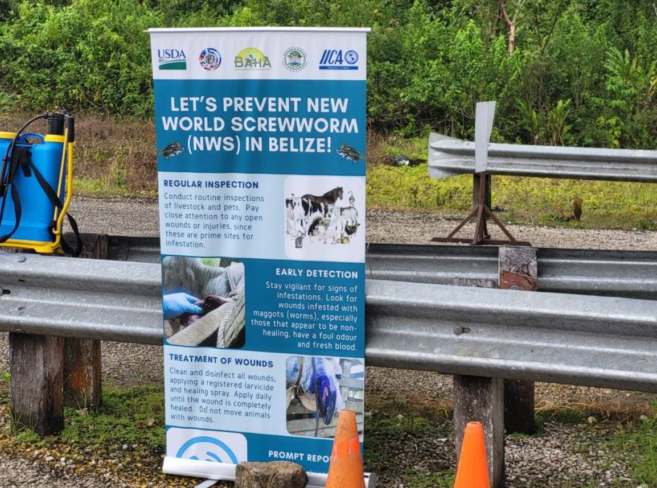Since January, Belize has been facing a rapid increase in cases of New World Screwworm (Cochliomyia hominivorax), with the outbreak spreading beyond its initial containment in the Toledo District. By March 21st, authorities confirmed 33 cases across multiple districts, including Cayo, Belize District, and Orange Walk. This shows a significant rise from the eight cases reported in February, indicating a growing threat to the country’s livestock sector .
The first case emerged in late December 2023 in the village of Crique Sarco, located in Toledo near the Guatemalan border. By January 23rd, five cases had been reported, including four cattle and one dog. By March, the parasite had spread to four districts, with Toledo still bearing the brunt of the outbreak, accounting for 27 cases.

Affected animals now include pigs, sheep, horses, and dogs, highlighting the parasite’s adaptability. The Belize Agricultural Health Authority (BAHA) and the Ministry of Agriculture, Food Security, and Enterprise (MAFSE) have implemented strict measures, including the establishment of expanded checkpoints at Jalacte, Bullet Tree, and Bella Vista, which mandate vehicle sanitization and animal inspections. Cattle exports to Mexico continue under a joint inspection system, where infested animals are treated and then re-exported after recovery.
Non-compliance may result in fines of up to $5,000 or imprisonment. Despite these efforts, the spread of the parasite highlights challenges in cross-border containment, particularly given its suspected origin in Guatemala. Screwworm infestations can lead to serious wounds in cattle, reducing herd productivity and jeopardizing export viability.
While Mexico remains a significant buyer of Belizean cattle, prolonged outbreaks could threaten the country’s trade relations. Cattle exports are vital for Belize’s economy, and if the infestation is not controlled, it could result in market closures that would have a significant impact on rural livelihoods. Additionally, the parasite’s movement northward from Panama since 2023 raises concerns that Belize may become a pathway for further regional infestations.
In a recent interview, Prime Minister John Briceño has downplayed the immediate risks associated with this issue. “We did not bring the screwworm it is a mistake done in Panama when they released the insects in error and that progressively came to us. They didn’t put enough effort to stop it back then.
Now it is here and we are trying our best to contain it. What is important is that we are worked out a protocol with the Mexicans on how to export our cattle. This is not something that affects the meat.
If you see the animal with the screwworm, you cure it, and five days later, it is a healthy animal. So the plan is we have a coral area where we inspect the animal in Belize and it goes over to the Mexican side and they inspect. If they see any animal with signs of screwworm, they send it back, we cure it and five six days later we can send it back.
” BAHA continues to urge vigilance, emphasizing the importance of wound inspections and rapid reporting. As cases increase, the stakes grow higher for Belize’s agricultural economy and regional biosecurity. Cases of suspected larval infestations in animals can be reported to the BAHA Animal Health Department offices at 302-1388 in Orange Walk, 824-4872 in Central Farm, or via WhatsApp at 670-7003.
.
Health

New World Screwworm Cases continue to climb across Belize

Since January, Belize has been facing a rapid increase in cases of New World Screwworm (Cochliomyia hominivorax), with the outbreak spreading beyond its initial containment in the Toledo District. By March 21st, authorities confirmed 33 cases across multiple districts, including Cayo, Belize District, and Orange Walk. This shows a significant rise from the eight cases reported in February, indicating a growing threat to the country's livestock sector.















